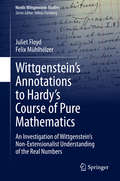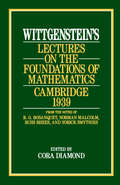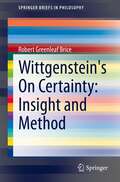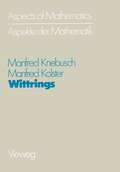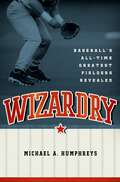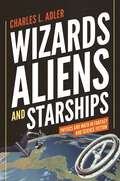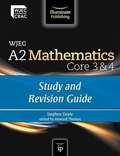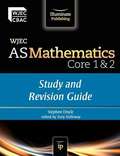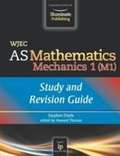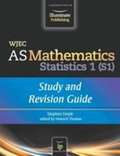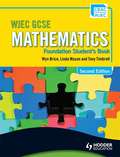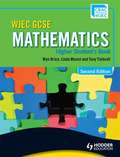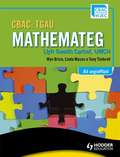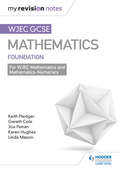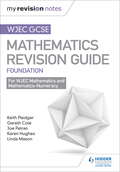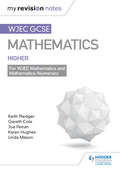- Table View
- List View
Wittgenstein’s Annotations to Hardy’s Course of Pure Mathematics: An Investigation of Wittgenstein’s Non-Extensionalist Understanding of the Real Numbers (Nordic Wittgenstein Studies #7)
by Juliet Floyd Felix MühlhölzerThis monograph examines the private annotations that Ludwig Wittgenstein made to his copy of G.H. Hardy’s classic textbook, A Course of Pure Mathematics. Complete with actual images of the annotations, it gives readers a more complete picture of Wittgenstein’s remarks on irrational numbers, which have only been published in an excerpted form and, as a result, have often been unjustly criticized. The authors first establish the context behind the annotations and discuss the historical role of Hardy’s textbook. They then go on to outline Wittgenstein’s non-extensionalist point of view on real numbers, assessing his manuscripts and published remarks and discussing attitudes in play in the philosophy of mathematics since Dedekind. Next, coverage focuses on the annotations themselves. The discussion encompasses irrational numbers, the law of excluded middle in mathematics and the notion of an “improper picture," the continuum of real numbers, and Wittgenstein’s attitude toward functions and limits.
Wittgenstein's Lectures on the Foundations of Mathematics, Cambridge, 1939
by Ludwig WittgensteinFor several terms at Cambridge in 1939, Ludwig Wittgenstein lectured on the philosophical foundations of mathematics. A lecture class taught by Wittgenstein, however, hardly resembled a lecture. He sat on a chair in the middle of the room, with some of the class sitting in chairs, some on the floor. He never used notes. He paused frequently, sometimes for several minutes, while he puzzled out a problem. He often asked his listeners questions and reacted to their replies. Many meetings were largely conversation. These lectures were attended by, among others, D. A. T. Gasking, J. N. Findlay, Stephen Toulmin, Alan Turing, G. H. von Wright, R. G. Bosanquet, Norman Malcolm, Rush Rhees, and Yorick Smythies. Notes taken by these last four are the basis for the thirty-one lectures in this book. The lectures covered such topics as the nature of mathematics, the distinctions between mathematical and everyday languages, the truth of mathematical propositions, consistency and contradiction in formal systems, the logicism of Frege and Russell, Platonism, identity, negation, and necessary truth. The mathematical examples used are nearly always elementary.
Wittgenstein's Lectures on the Foundations of Mathematics, Cambridge, 1939: From The Notes Of R. G. Bosanquet, Norman Malcolm, Rush Rhees, And Yorick Smythies
by Ludwig WittgensteinFor several terms at Cambridge in 1939, Ludwig Wittgenstein lectured on the philosophical foundations of mathematics. A lecture class taught by Wittgenstein, however, hardly resembled a lecture. He sat on a chair in the middle of the room, with some of the class sitting in chairs, some on the floor. He never used notes. He paused frequently, sometimes for several minutes, while he puzzled out a problem. He often asked his listeners questions and reacted to their replies. Many meetings were largely conversation. These lectures were attended by, among others, D. A. T. Gasking, J. N. Findlay, Stephen Toulmin, Alan Turing, G. H. von Wright, R. G. Bosanquet, Norman Malcolm, Rush Rhees, and Yorick Smythies. Notes taken by these last four are the basis for the thirty-one lectures in this book. The lectures covered such topics as the nature of mathematics, the distinctions between mathematical and everyday languages, the truth of mathematical propositions, consistency and contradiction in formal systems, the logicism of Frege and Russell, Platonism, identity, negation, and necessary truth. The mathematical examples used are nearly always elementary.
Wittgenstein's Lectures on the Foundations of Mathematics, Cambridge, 1939: From The Notes Of R. G. Bosanquet, Norman Malcolm, Rush Rhees, And Yorick Smythies
by Ludwig WittgensteinFor several terms at Cambridge in 1939, Ludwig Wittgenstein lectured on the philosophical foundations of mathematics. A lecture class taught by Wittgenstein, however, hardly resembled a lecture. He sat on a chair in the middle of the room, with some of the class sitting in chairs, some on the floor. He never used notes. He paused frequently, sometimes for several minutes, while he puzzled out a problem. He often asked his listeners questions and reacted to their replies. Many meetings were largely conversation. These lectures were attended by, among others, D. A. T. Gasking, J. N. Findlay, Stephen Toulmin, Alan Turing, G. H. von Wright, R. G. Bosanquet, Norman Malcolm, Rush Rhees, and Yorick Smythies. Notes taken by these last four are the basis for the thirty-one lectures in this book. The lectures covered such topics as the nature of mathematics, the distinctions between mathematical and everyday languages, the truth of mathematical propositions, consistency and contradiction in formal systems, the logicism of Frege and Russell, Platonism, identity, negation, and necessary truth. The mathematical examples used are nearly always elementary.
Wittgenstein's Lectures on the Foundations of Mathematics, Cambridge, 1939: From The Notes Of R. G. Bosanquet, Norman Malcolm, Rush Rhees, And Yorick Smythies
by Ludwig WittgensteinFor several terms at Cambridge in 1939, Ludwig Wittgenstein lectured on the philosophical foundations of mathematics. A lecture class taught by Wittgenstein, however, hardly resembled a lecture. He sat on a chair in the middle of the room, with some of the class sitting in chairs, some on the floor. He never used notes. He paused frequently, sometimes for several minutes, while he puzzled out a problem. He often asked his listeners questions and reacted to their replies. Many meetings were largely conversation. These lectures were attended by, among others, D. A. T. Gasking, J. N. Findlay, Stephen Toulmin, Alan Turing, G. H. von Wright, R. G. Bosanquet, Norman Malcolm, Rush Rhees, and Yorick Smythies. Notes taken by these last four are the basis for the thirty-one lectures in this book. The lectures covered such topics as the nature of mathematics, the distinctions between mathematical and everyday languages, the truth of mathematical propositions, consistency and contradiction in formal systems, the logicism of Frege and Russell, Platonism, identity, negation, and necessary truth. The mathematical examples used are nearly always elementary.
Wittgenstein's On Certainty: Insight and Method (SpringerBriefs in Philosophy)
by Robert Greenleaf BriceThis book considers the important twentieth century Austrian philosopher, Ludwig Wittgenstein, and his conception of certainty. In his work entitled On Certainty, Wittgenstein provides not only a brilliant solution to a previously intractable philosophical problem, but also the elements of an entirely new way of approaching this and similar longstanding, apparently unresolvable, problems. In On Certainty, he re-conceives the problem of radical skepticism–the claim that we can never really be certain of anything except the contents of our own minds–as a kind of philosophical “disease” of thought. His approach to the problem, which is emphasized in the book, is similar to the treatment of disease, has two main goals: (1) bring about an awareness in the philosopher that this kind of extreme skepticism is not a methodological approach to be taken seriously, and, with this awareness, (2) an attempt to replace this radical skepticism with a practical, Common Sense framework. Implicit in Wittgenstein’s approach are a number of strategies found in a contemporary approach to psychotherapy known as Cognitive Behavioral Therapy (CBT). These strategies, along with philosophical methods and scientific practices rooted in the Scottish School of Common Sense, seek to diagnose and treat irrational thoughts and beliefs that often emerge (and re-emerge) in the discipline of philosophy. The aim of this book, then, is to provide students of philosophy with the tools necessary to adjust and reshape these irrational, self-defeating thoughts and beliefs into something new, something healthy.
Wizardry: Baseball's All-Time Greatest Fielders Revealed
by Michael HumphreysThe systematic analysis of baseball statistics, often called "sabermetrics," has evolved in recent years to resemble something of a science, attracting fans from diverse professional and educational backgrounds, all fascinated by the analysis itself and its insights into the game. But one problem has defied solution: estimating runs saved by fielders throughout history. Traditional statistics include errors and plays made, but not hits that could or should have been prevented. The latter can now be estimated using records of the location of every batted ball, but the underlying data exists only for recent seasons and has generally been withheld from the public. Now, in Wizardry, comes the long-awaited breakthrough. Drawing solely on freely available baseball statistics, Michael A. Humphreys shows how to apply classic statistical methods to estimate runs saved by fielders going back to 1893. Humphreys tests his results against other fielding measures, including published ratings based on proprietary batted ball location data, and explains their respective strengths and limitations. He also introduces a method for adjusting historical player ratings for increased competition due to population growth, integration, and international recruitment. Position by position, Humphreys identifies and profiles the greatest fielders of all time with anecdote-rich essays. Sabermetrics changed baseball and introduced a generation to the art of statistical inference. Wizardry makes the case for the most significant changes in historical player valuation in decades, while opening up new approaches for further exploration.
Wizardry: Baseball's All-Time Greatest Fielders Revealed
by Michael HumphreysThe systematic analysis of baseball statistics, often called "sabermetrics," has evolved in recent years to resemble something of a science, attracting fans from diverse professional and educational backgrounds, all fascinated by the analysis itself and its insights into the game. But one problem has defied solution: estimating runs saved by fielders throughout history. Traditional statistics include errors and plays made, but not hits that could or should have been prevented. The latter can now be estimated using records of the location of every batted ball, but the underlying data exists only for recent seasons and has generally been withheld from the public. Now, in Wizardry, comes the long-awaited breakthrough. Drawing solely on freely available baseball statistics, Michael A. Humphreys shows how to apply classic statistical methods to estimate runs saved by fielders going back to 1893. Humphreys tests his results against other fielding measures, including published ratings based on proprietary batted ball location data, and explains their respective strengths and limitations. He also introduces a method for adjusting historical player ratings for increased competition due to population growth, integration, and international recruitment. Position by position, Humphreys identifies and profiles the greatest fielders of all time with anecdote-rich essays. Sabermetrics changed baseball and introduced a generation to the art of statistical inference. Wizardry makes the case for the most significant changes in historical player valuation in decades, while opening up new approaches for further exploration.
Wizards, Aliens, and Starships: Physics and Math in Fantasy and Science Fiction
by Charles L. AdlerFrom teleportation and space elevators to alien contact and interstellar travel, science fiction and fantasy writers have come up with some brilliant and innovative ideas. Yet how plausible are these ideas--for instance, could Mr. Weasley's flying car in the Harry Potter books really exist? Which concepts might actually happen, and which ones wouldn’t work at all? Wizards, Aliens, and Starships delves into the most extraordinary details in science fiction and fantasy--such as time warps, shape changing, rocket launches, and illumination by floating candle--and shows readers the physics and math behind the phenomena.With simple mathematical models, and in most cases using no more than high school algebra, Charles Adler ranges across a plethora of remarkable imaginings, from the works of Ursula K. Le Guin to Star Trek and Avatar, to explore what might become reality. Adler explains why fantasy in the Harry Potter and Dresden Files novels cannot adhere strictly to scientific laws, and when magic might make scientific sense in the muggle world. He examines space travel and wonders why it isn’t cheaper and more common today. Adler also discusses exoplanets and how the search for alien life has shifted from radio communications to space-based telescopes. He concludes by investigating the future survival of humanity and other intelligent races. Throughout, he cites an abundance of science fiction and fantasy authors, and includes concise descriptions of stories as well as an appendix on Newton's laws of motion.Wizards, Aliens, and Starships will speak to anyone wanting to know about the correct--and incorrect--science of science fiction and fantasy.
Wizards, Aliens, and Starships: Physics and Math in Fantasy and Science Fiction
by Charles L. AdlerFrom teleportation and space elevators to alien contact and interstellar travel, science fiction and fantasy writers have come up with some brilliant and innovative ideas. Yet how plausible are these ideas--for instance, could Mr. Weasley's flying car in the Harry Potter books really exist? Which concepts might actually happen, and which ones wouldn’t work at all? Wizards, Aliens, and Starships delves into the most extraordinary details in science fiction and fantasy--such as time warps, shape changing, rocket launches, and illumination by floating candle--and shows readers the physics and math behind the phenomena.With simple mathematical models, and in most cases using no more than high school algebra, Charles Adler ranges across a plethora of remarkable imaginings, from the works of Ursula K. Le Guin to Star Trek and Avatar, to explore what might become reality. Adler explains why fantasy in the Harry Potter and Dresden Files novels cannot adhere strictly to scientific laws, and when magic might make scientific sense in the muggle world. He examines space travel and wonders why it isn’t cheaper and more common today. Adler also discusses exoplanets and how the search for alien life has shifted from radio communications to space-based telescopes. He concludes by investigating the future survival of humanity and other intelligent races. Throughout, he cites an abundance of science fiction and fantasy authors, and includes concise descriptions of stories as well as an appendix on Newton's laws of motion.Wizards, Aliens, and Starships will speak to anyone wanting to know about the correct--and incorrect--science of science fiction and fantasy.
WJEC A2 Mathematics Core 3 & 4: Study and Revision Guide (PDF)
by Stephen DoyleEndorsed by WJEC, and written by bestselling author Stephen Doyle and edited by Tony Holloway, the Chair of Examiners for a major awarding body, this is the only book that precisely matches the WJEC A2 Mathematics Core 3 amp; 4 course. It contains essential course notes, revision advice and support and practice for every topic in the specification.
WJEC A2 Mathematics Core 3 & 4: Study and Revision Guide (PDF)
by Stephen Doyle Howard ThomasEndorsed by WJEC, and written by bestselling author Stephen Doyle and edited by Howard Thomas, former Senior Examiner for a major awarding body, this is the only book that precisely matches the WJEC A2 Mathematics Core 3 & 4 course. It contains essential course notes, revision advice and support and practice for every topic in the specification.
WJEC AS Mathematics Core 1 & 2: Study and Revision Guide (PDF)
by Stephen Doyle Tony HollowayEndorsed by WJEC, and written by bestselling author Stephen Doyle and edited by Tony Holloway, the Chair of Examiners for a major awarding body, this is the only book that precisely matches the WJEC AS Mathematics Core 1 & 2 course. It contains essential course notes, revision advice and support and practice for every topic in the specification.
WJEC AS Mathematics M1 Mechanics: Study and Revision Guide (PDF)
by Stephen Doyle Howard ThomasWritten specifically for the WJEC AS Mathematics Mechanics 1 (M1) unit and endorsed by WJEC, this study and revision guide is designed to accompany you through your course and prepare you for your final exams.
WJEC AS Mathematics Mechanics 1 (M1): Study and Revision Guide (PDF)
by Stephen DoyleEndorsed by WJEC, and written by bestselling author Stephen Doyle and edited by Dr Howard Thomas, former Senior Examiner for a major awarding body, this is the only book that precisely matches the WJEC AS Mathematics Mechanics 1 (M1) course. It offers invaluable study support for students and authoritative guidance and advice for the exams.
WJEC AS Mathematics S1 Statistics: Study and Revision Guide (PDF)
by Stephen Doyle Howard ThomasEndorsed by WJEC, and written by bestselling author Stephen Doyle and edited by Dr Howard Thomas, former Senior Examiner for a major awarding body, this is the only book that precisely matches the WJEC AS Mathematics Statistics S1 course. It offers invaluable study support for students and authoritative guidance and advice for the exams.
WJEC AS Mathematics Statistics 1 (S1): Study and Revision Guide (PDF)
by Stephen DoyleEndorsed by WJEC, and written by bestselling author Stephen Doyle and edited by Dr Howard Thomas, former Senior Examiner for a major awarding body, this is the only book that precisely matches the WJEC AS Mathematics Statistics S1 course. It offers invaluable study support for students and authoritative guidance and advice for the exams.
WJEC AS Mathematics. Study and Revision Guide (PDF)
by Stephen DoyleEndorsed by WJEC, and written by bestselling author Stephen Doyle and edited by Tony Holloway, the Chair of Examiners for a major awarding body, this is the only book that precisely matches the WJEC AS Mathematics Core 1 amp; 2 course. It contains essential course notes, revision advice and support and practice for every topic in the specification.
WJEC GCSE Mathematics: Foundation Student's Book (2nd edition) (PDF)
by Linda Mason Wyn Brice Tony TimbrellThis Student's Book provides ideal preparation for the new 2010 WJEC GCSE in Mathematics specification at the Foundation tier. It offers comprehensive guidance and practice for tackling problem-solving questions and the functional elements of mathematics - how maths is applied in everyday life. Fully supported by a Teacher's Resource and Homework Book, learners are encouraged to develop confidence in, and a positive attitude towards, mathematics. Endorsed by WJEC for use with GCSE in Mathematics. Complete coverage of all Units (1, 2, and 3) is provided through questions that increase in difficulty across the chapters and related revision activities. Learning objectives and summaries for each chapter are written in a student-friendly style. Exam tips help learners to focus on key areas for their revision, and open-ended challenges stretch students' skills and knowledge. The same author team delivered Hodder's successful resources for the current WJEC Mathematics specification. The writers include current Chair of Examiners for GCSE Mathematics and current Chief Examiner of the two-tier Foundation Level specification. Their extensive teaching experience includes Head of Mathematics in schools in Wales as well as Senior Education Advisor roles. The series includes dedicated Student Books, Homework Books, and Teacher's Resources for both tiers.
WJEC GCSE Mathematics - Higher Student's Book (PDF)
by Wyn Brice Linda Mason Tony TimbrellThis Student's Book provides ideal preparation for the new 2010 WJEC GCSE in Mathematics specification at the Higher tier. It offers comprehensive guidance and practice for tackling problem-solving questions and the functional elements of mathematics - how maths is applied in everyday life. Fully supported by a Teacher's Resource and Homework Book, learners are encouraged to develop confidence in, and a positive attitude towards, mathematics. - Endorsed by WJEC for use with GCSE in Mathematics. - Complete coverage of all Units (1, 2, and 3) is provided through questions that increase in difficulty across the chapters and related revision activities. - Learning objectives and summaries for each chapter are written in a student-friendly style. - Exam tips help learners to focus on key areas for their revision, and open-ended challenges stretch students' skills and knowledge. - The same author team delivered Hodder's successful resources for the current WJEC Mathematics specification. The writers include current Chair of Examiners for GCSE Mathematics and current Chief Examiner of the two-tier Foundation Level specification. Their extensive teaching experience includes Head of Mathematics in schools in Wales as well as Senior Education Advisor roles. The series includes dedicated Student Books, Homework Books, and Teacher's Resources for both tiers.
WJEC GCSE Maths: Llyfr Gwaith Cartref, UWCH (2nd Welsh editio (PDF)
by Linda Mason Wyn Brice Tony TimbrellThis Homework Book provides ideal preparation for the new 2010 WJEC GCSE in Mathematics specification at the Higher tier.nbsp; The teachers and examiners who have written the course have used their extensive experience of both teaching and examining to write lots of practice questions and homework that mirror each exercise in the Student's Book.nbsp;
WJEC GCSE Maths Foundation: Mastering Mathematics Revision Guide
by Keith Pledger Joe Petran Gareth ColeMaximise your students' grade potential with a step-by-step approach that builds confidence through topic summaries, worked examples and exam style questions- Identify areas of improvement to focus on through diagnostic tests for each topic.- Develop exam skills and techniques with skills-focused exam-style questions and exam advice on common pitfalls.- Build understanding and confidence with clear explanations of each topic covering all the key information needed to succeed.- Consolidate revision with 'two weeks to go' summaries for each topic.
WJEC GCSE Maths Foundation: Mastering Mathematics Revision Guide
by Keith Pledger Joe Petran Gareth ColeExam Board: WJECLevel: GCSESubject: MathematicsFirst Teaching: September 2015First Exam: June 2017Maximise your students' grade potential with a step-by-step approach that builds confidence through topic summaries, worked examples and exam style questions- Identify areas of improvement to focus on through diagnostic tests for each topic.- Develop exam skills and techniques with skills-focused exam-style questions and exam advice on common pitfalls.- Build understanding and confidence with clear explanations of each topic covering all the key information needed to succeed.- Consolidate revision with 'two weeks to go' summaries for each topic.
WJEC GCSE Maths Higher: Mastering Mathematics Revision Guide (PDF)
by Keith Pledger Joe Petran Gareth ColeMaximise your students' grade potential with a step-by-step approach that builds confidence through topic summaries, worked examples and exam style questions.- Identify areas of improvement to focus on through diagnostic tests for each topic.- Develop exam skills and techniques with skills-focused exam-style questions and exam advice on common pitfalls.- Build understanding and confidence with clear explanations of each topic covering all the key information needed to succeed.- Consolidate revision with 'two weeks to go' summaries for each topic.
